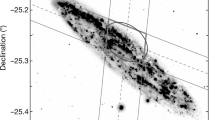Abstract
Although there is no agreement concerning the model and mechanisms responsible for γ-ray bursts, it is generally agreed that they are produced by neutron stars1. With few exceptions2, it is thought that an intense magnetic field plays a key role. The favoured radiation mechanism is optically thin synchrotron radiation3, but it is difficult to find any way of maintaining the electron energy since the radiation cooling time is extremely short. As a resolution of this difficulty, I propose that the basic energy-release mechanism is a flare in the magnetosphere of a neutron star. This involves reconnection that leads to an electric field parallel to the magnetic field. This accelerates an electron along the magnetic field, producing high-energy γ rays (by curvature radiation) that promptly annihilate in the magnetic field, resulting in an electron-positron cascade as in radio pulsars4. This model offers an explanation of the continuum spectrum, of the 511-keV annihilation line, and possibly of the optical radiation that seems to accompany some γ-ray bursts.
This is a preview of subscription content, access via your institution
Access options
Subscribe to this journal
Receive 51 print issues and online access
$199.00 per year
only $3.90 per issue
Buy this article
- Purchase on Springer Link
- Instant access to full article PDF
Prices may be subject to local taxes which are calculated during checkout
Similar content being viewed by others
References
Woosley, S. E. (ed.) High Energy Transients in Astrophysics (American Institute of Physics, New York, 1984).
Colgate, S. A., Petschek, A. G. & Sarracino, R. In High-Energy Transients in Astropphysics (ed. Woolsey, S. E.) 548–554 (American Institute of Physics, New York, 1984).
Lamb, D. Q. in High Energy Transients in Astrophysics (ed. Woosley, S. E.) 512–547 (American Institute of Physics, New York, 1984).
Sturrock, P. A. Astrophys. J. 164, 529–556 (1971).
Hameury, J. M., Lasota, J. P., Bonazzola, S. & Heyvaerts, J. Astrophys. J. 293 56–68.
Liang, E. P. in High Energy Transients in Astrophysics (ed. Woosley, S. E.) 597–604 (American Institute of Physics, New York, 1984).
Liang, E. P. & Antiochos, S. K. Nature 310, 121–122 (1984).
Svestka, Z. Solar Flares (Reidel, Dordrecht, 1976).
Sturrock, P. A. in Solar Flares (ed. Sturrock, P. A.) 411–449 (Colorado University Press, Boulder, Colorado, 1980).
Soward, A. M. & Priest, E. R. Phil. Trans. R. Soc. A284, 369–417 (1974).
Barat, C. in Positron-Electron Pairs in Astrophysics (eds Burns, M. L., Harding, A. K. & Ramaty, R.) 54–58 (American Institute of Physics, New York, 1983).
Nolan, P. L., Share, G. H., Forrest, D. J., Chupp, E. L., Matz, S. & Rieger, E. in Positron-Electron Pairs in Astrophysics (eds Burns, M. L., Harding, A. K. & Ramaty, R.) 59–63 (American Institute of Physics, New York, 1983).
Nolan, P. L., Share, G. H., Matz, S., Chupp, E. L., Forrest, D. J. & Rieger, E. in High-Eenergy Transients in Astrophysics (ed. Woosley, S. E.) 399–402 (American Institute of Physics, New York, 1984).
Kundu, M. R. Solar Radio Astronomy (Interscience, New York, 1965).
Liang, E. P. Nature 313, 202–204 (1985).
Schaefer, B. E. Nature 294, 722–724 (1981).
Schaefer, B. E., Seitzer, P. & Bradt, H. V. Astrophys. J. Lett. 270, L49–L52 (1983).
Heyvaerts, J., Priest, E. R. & Rust, D. M. Astrophys. J. 216, 123–137 (1977).
Sturrock, P. A., Kaufman, P., Moore, R. L. & Smith, D. F. Solar Phys. 94, 341–357 (1984).
Manchester, R. N. & Taylor, J. H. Pulsars, 164 (Freeman, San Francisco, (1977).
Author information
Authors and Affiliations
Rights and permissions
About this article
Cite this article
Sturrock, P. A flare-induced cascade model of γ-ray bursts. Nature 321, 47–49 (1986). https://doi.org/10.1038/321047a0
Received:
Accepted:
Issue Date:
DOI: https://doi.org/10.1038/321047a0
This article is cited by
-
Annihilation radiation from a power-law distributed electron-positron plasma on the ground Landau level: the case of low magnetic fields
Astrophysics and Space Science (1992)
Comments
By submitting a comment you agree to abide by our Terms and Community Guidelines. If you find something abusive or that does not comply with our terms or guidelines please flag it as inappropriate.



